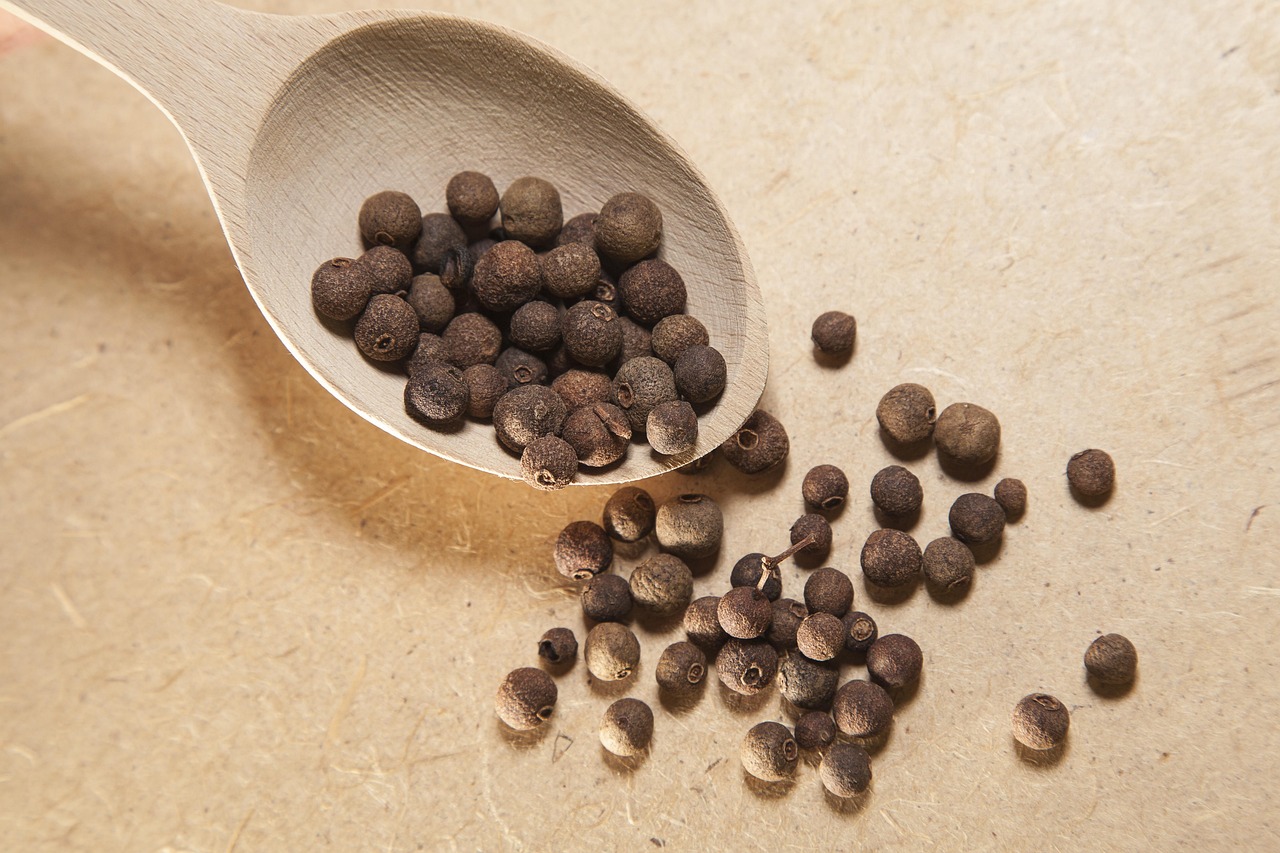Allspice (Pimenta dioica) is the dried berry of an evergreen tree native to the Greater Antilles, southern Mexico, and parts of Central America. It was introduced to the Old World following the Columbian Exchange, eventually becoming a key spice in several global cuisines, including those of the Middle East. The English name “allspice,” first documented in 1621, reflects the berry’s distinctive aroma, which combines the flavors of cinnamon, nutmeg, and cloves into a single spice[1].
The allspice tree thrives in warm, humid climates with well-drained soil, and the berries are harvested while still green and unripe, then dried until they turn dark brown[2]. The spice contains high levels of essential oils—particularly eugenol—which contribute to its warming fragrance and preservative properties[2]. Because of its unique flavor profile and versatility, allspice became an important ingredient in both sweet and savory dishes as it spread from the Caribbean into Europe, the Ottoman Empire, and eventually the broader Middle East[3][10].

Cultural Relevance of Allspice
Allspice entered Middle Eastern cuisine through Ottoman-era trade networks after the sixteenth century. Although native to the Caribbean and entirely unknown in the ancient Middle East, it became increasingly common in the region once European merchants began transporting the dried berries into Mediterranean ports. Ottoman commercial centers such as Alexandria, Aleppo, and İzmir became primary gateways through which allspice reached Syrian, Lebanese, and Palestinian markets[7][8].
By the eighteenth century, allspice had become a familiar ingredient in Levantine kitchens. Middle Eastern cooks quickly recognized its value as a single spice with the warming qualities of several traditional spices such as cinnamon, nutmeg, and cloves[9][10]. As its use spread, allspice became a defining component of local cooking, particularly in rice dishes, meat stews, kibbeh, kafta, and stuffed vegetables. It was also incorporated into the regional spice blend baharat, where it remains an essential ingredient today[5].
Although a relatively recent arrival compared to native Middle Eastern spices, allspice became so central to Levantine cuisine that it is now considered one of the foundational flavors of Syrian, Lebanese, Jordanian, and Palestinian home cooking[4].
Allspice plays a significant role in global cooking, but it is especially prominent in Levantine cuisine, where it is known as bahar, baharat helew, or simply allspice. It is one of the defining spices of Syrian, Lebanese, Jordanian, and Palestinian cooking today. Its warm, aromatic character allows it to deepen the flavor of braised meats, rice dishes, and tomato-based stews, making it one of the most frequently used spices in home cooking throughout the region[3][4].
Levantine and Middle Eastern Cooking
In the Levant, allspice is used to season a wide variety of staple dishes, including spiced rice pilafs, stuffed vegetables (mahshi), kibbeh, kafta, roasted meats, and hearty winter stews. Because its flavor resembles a blend of multiple warming spices, many Levantine families traditionally rely on it as the primary spice for everyday savory dishes[4]. In some communities, allspice is favored even above cinnamon or cloves for meat-based dishes due to its depth and subtle sweetness.
Spice Blends
Allspice is also a central ingredient in baharat, a widely used Middle Eastern spice blend that varies by region but typically includes black pepper, cumin, coriander, cinnamon, cloves, nutmeg, and paprika[5]. In many formulations—especially in the Levant and parts of the Arabian Peninsula—allspice is among the dominant components, contributing much of the blend’s warmth and distinctive aroma[5]. Baharat is used to season grilled meats, rice dishes, sauces, and soups throughout the Middle East, making allspice one of the most influential imported spices in regional cooking since the early Ottoman era[7][8].
Beyond baharat, allspice appears in other spice mixtures, such as kibbeh spice blends, shawarma seasonings, and certain coastal Levantine fish seasonings. Its versatility allows it to be used in both savory and sweet preparations, though Middle Eastern cooking tends to favor allspice for meats, rice, and vegetable dishes rather than desserts[4][6].
Sources & Additional Information
- Wikipedia Contributors. “Allspice.” Wikipedia, Wikimedia Foundation, 25 Mar. 2019, https://en.wikipedia.org/wiki/Allspice.
- “Allspice | Tree and Spice.” Encyclopedia Britannica, www.britannica.com/plant/allspice.
- “The History of Allspice: From the Caribbean to Kitchens Worldwide - Spices Masala.” Spices Masala, 11 Feb. 2022, www.spicesmasala.com/blog/the-history-of-allspice. Accessed 24 Nov. 2025.
- “Spice Merchant Diary: Baharat.” SBS Food, 5 Sept. 2013, www.sbs.com.au/food/article/spice-merchant-diary-baharat/t6qshsine. Accessed 24 Nov. 2025.
- “Baharat.” Wikipedia, Wikimedia Foundation, 23 Nov. 2025, https://en.wikipedia.org/wiki/Baharat.
- “What Is Allspice? How to Use the Warm Spice for Dry Rubs, Cake, and More.” Food & Wine, 2024, www.foodandwine.com/what-is-allspice-8672958. Accessed 24 Nov. 2025.
- Özbaran, Salih. “Ottoman Empire and the Spice Routes in the 16th Century | Silk Roads Programme.” En.unesco.org, 30 Oct. 1990, https://en.unesco.org/silkroad/knowledge-bank/ottoman-empire-and-spice-routes-16th-century.
- Neslihan Koçak. “Spicing It Up: Aromatic Journey from Orient to Europe | Daily Sabah.” Daily Sabah, 2 Jan. 2023, www.dailysabah.com/life/food/spicing-it-up-aromatic-journey-from-orient-to-europe/amp. Accessed 24 Nov. 2025.
- “Essential Oil Contents and Ethnopharmacological Characteristics of Some Spices and Herbal Drugs Traded in Turkey.” Wisdomlib.org, 2 Aug. 2025, www.wisdomlib.org/journals/13931-essential-oil-contents-ethnopharmacological. Accessed 24 Nov. 2025.
- Kristina. “The History of Allspice in Culinary Traditions.” Savory Suitcase, 2 Dec. 2023, https://savorysuitcase.com/the-history-of-allspice-in-culinary-traditions/. Accessed 24 Nov. 2025.
